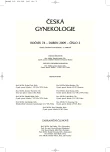Follicular fluid and serum concentrations of PAPP-A in OHSS risk group of women undergoing IVF stimulation
Authors:
K. Řežábek 1; Martina Moosová 1; J. Pavelková 1; J. Moos 2; V. Filová 3
Authors‘ workplace:
Centrum asistované reprodukce, Gynekologicko-porodnická klinika 1. LF UK a VFN, Praha přednosta prof. MUDr. A. Martan, DrSc.
1; Sigma-Aldrich spol. s r. o., Praha
2; Immunotech a. s., Praha
3
Published in:
Ceska Gynekol 2009; 74(2): 80-84
Category:
Original Article
Overview
Objective:
Ovarian Hyperstimulation Syndrome (OHSS) is a serious complication of In Vitro Fertilisation (IVF) treatment. It is estimated that 3-5% of treated women suffer of severe form of OHSS. OHSS pathogenesis remains unknown and its treatment is only symptomatic. It is difficult to predict the risk of OHSS of an individual woman, since a current criterion – the number of punctured follicles - is not very reliable.
Our aim was to find, whether in patients with a high risk of OHSS (more than 18 follicles punctured for oocyte pick-up) is possible to predict the individual risk of OHSS. As a marker we tested concentrations of Pregnancy Associated Plasma Protein - A (PAPP-A) in follicular fluid (FF) and blood serum (S).
Study design:
Prospective study.
Settings:
Assisted Reproduction Center, Clinic of Obstetrics and Gynecology, First Faculty of Medicine, Charles University in Prague and General Teaching Hospital in Prague.
Methodology:
Follicular fluid and serum of 118 female patients undergoing IVF treatment was collected at the day of oocyte pick-up and analysed for PAPP-A concentration. The resulting data were then correlated with the OHSS status of individual patient.
Results:
Mean concentration of PAPP-A in FF was 0,81 ± 0,29 IU/l, while in S it reached only 0.0017 ± 0.0003 IU/l. Patients with subsequent OHSS grade 1, 2 and 3 reached FF levels of PAPP-A 0.81; 0.52; and 0.73IU/l, respectively 0.0017; 0.0017 a 0.0017IU/l in blood serum. No correlation was found between PAPP-A FF or PAPP-A serum concentrations and the degree of OHSS.
No correlation was found between PAPP-A serum concentrations and the number of follicles.
Conclusion:
1. Pathological response on hormonal stimulation leading to OHSS is not related to the concentrations of PAPP-A in either FF or in blood serum. 2. PAPP-A does not pass from follicles to blood in a significant amount.
Key words:
IVF, OHSS, PAPP-A, follicular fluid.
Sources
1. Aboulghar, MA., Mansour, RT. Ovarian hyperstimulation syndrome: classifications and critical analysis of preventive measures. Hum Reprod Update, 2003, 9, 3, p. 275-289.
2. Conover, CA., Faessen, GF., Ilg, KE., et al. Pregnancy-associated plasma protein-a is the insulin-like growth factor binding protein-4 protease secreted by human ovarian granulosa cells and is a marker of dominant follicle selection and the corpus luteum. Endocrinology, 2001, 142, p. 2155.
3. Conover, CA., Bale, LK., Durham, SK., et al. Insulin-like growth factor (IGF) binding protein-3 potentiation of IGF action is mediated through the phosphatidylinositol-3-kinase pathway and is associated with alteration in protein kinase B/AKT sensitivity. Endocrinology, 2001, 142, 5, p. 2155.
4. Gérard, N., Oxvig, C., .et al. Proteolytic degradation of IGF-binding protein (IGFBP)-2 in equine ovarian follicles: involvement of pregnancy-associated plasma protein-A (PAPP-A) and association with dominant but not subordinated follicles. J Endocrinol., 2004, 182, 3, p. 457-466.
5. Hourvitz, A., Kuwahara, A., Hennebold, JD., et al. The regulated expression of the pregnancy-associated plasma protein-A in the rodent ovary: a proposed role in the development of dominant follicles and of corpora lutea. Endocrinology, 2002, 143, 5, p. 1833-1844.
6. Lawrence, JB., Oxvig, C., Overgaard, MT., et al. The insulin-like growth factor(IGF)-dependent binding protein-4 protease secreted by human fibroblasts is pregnancy associated plasma protein-A. Proc Natl Acad Sci USA, 96, p. 3149-3153.
8. Matsui, M., Sonntag, B., Hwang, SS., et al. Pregnancy-associated plasma protein-a production in rat granulosa cells: stimulation by follicle-stimulating hormone and inhibition by the oocyte-derived bone morphogenetic protein-15. Endocrinology, 2004, 145, p. 3686-3695.
9. Mazerbourg, S., Overgaard, MT., Oxvig, C., et al. Pregnancy-associated plasma protein-A (PAPP-A) in ovine, bovine, porcine, and equine ovarian follicles: involvement in IGF binding protein-4 proteolytic degradation and mRNA expression during follicular development. Endocrinology, 2001, 142, 12, p. 5243-5253.
10. Moos, J., Filova, V., Pavelkova, J., et al. Follicular fluid and serum levels of Inhibin A and pregnancy-associated plasma protein A in patients undergoing IVF. Fertil Steril, 2008, E pub ahead of print.
11. Nardo, LG., Bellanca, SA., Burrello, N., et al. Concentrations of insulin-like growth factor (IGF)-I and IGF binding protein-3 in the follicular fluid of women undergoing ovarian hyperstimulation with different gonadotropin preparations. Gynecol Endocrinol., 2001, 15, 6, p. 413-420.
12. Overgaard, MT., Haaning, J., Boldt, HB., et al. Expression of recombinant human pregnancy-associated plasma protein-A and identification of the proform of eosinophil major basic protein as its physiological inhibitor. J Biol Chem, 2000, 275, p. 31128-31133.
13. Oxvig, C., Sand, O., Kristensen, T., et al. Circulating human pregnancy-associated plasma protein-A is disulfide-bridged to the proform of eosinophil major basic protein. J Biol Chem, 1993, 268, p. 12243-12246.
14. Sinosich, MJ., Porter, R., Sloss, P., et al. Pregnancy-associated plasma protein A in human ovarian follicular fluid. J Clin Endocrinol Metab, 1984, 58, p.500-504.
15. Young, Sik Choi, Seung-Yup, Ku, Byung-Chul, Jee, et al. Comparison of follicular fluid IGF-I, IGF-II, IGFBP-3, IGFBP-4 and PAPP-A concentrations and their ratios between GnRH agonist and GnRH antagonist protocols for controlled ovarian stimulation in IVF-embryo transfer patients. Hum Reprod, 2006, 21, 8, p. 2015-2021.
Labels
Paediatric gynaecology Gynaecology and obstetrics Reproduction medicineArticle was published in
Czech Gynaecology

2009 Issue 2
Most read in this issue
- Sexual Functions after Laparoscopically Assisted Vaginal Hysterectomy (LAVH) and Total Laparoscopic Hysterectomy (TLH) in preoperatively asymptomatic women
- Thermachoice thermal baloon therapy – a 10-year-experience
- Fitz-Hugh-Curtis syndrome: a case report
- Ovarian remnant syndrome
